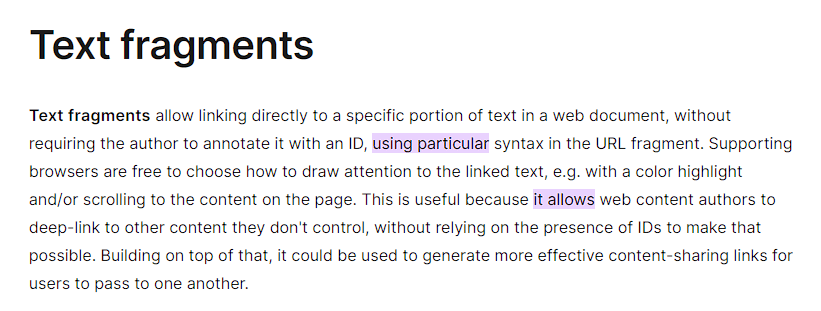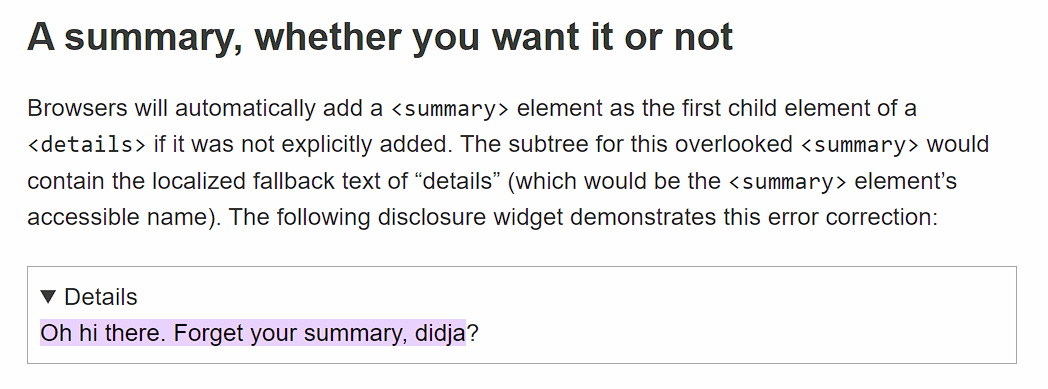直接链接网页的某段文本_raw
Title: Smarter than ‘Ctrl+F’: Linking Directly to Web Page Content
URL Source: https://alfy.blog/2024/10/19/linking-directly-to-web-page-content.html
Published Time: 2024-10-19T03:00:00+03:00
Markdown Content: Historically, we could link to a certain part of the page only if that part had an ID. All we needed to do was to link to the URL and add the document fragment (ID). If we wanted to link to a certain part of the page, we needed to anchor that part to link to it. This was until we were blessed with the Text fragments!
What are Text fragments?
Text fragments are a powerful feature of the modern web platform that allows for precise linking to specific text within a web page without the need to add an anchor! This feature is complemented by the ::target-text CSS pseudo-element, which provides a way to style the highlighted text.
Text fragments work by appending a special syntax to the end of a URL; just like we used to append the ID after the hash symbol (#). The browser interprets this part of the URL, searches for the specified text on the page, and then scrolls to and highlights that text if it supports text fragments. If the user attempts to navigate the document by pressing tab, the focus will move on to the next focusable element after the text fragment.
How can we use it?
Here’s the basic syntax for a text fragment URL:
https://example.com/page.html#:~:text=[prefix-,]textStart[,textEnd][,-suffix]
Following the hash symbol, we add this special syntax :~: also known as fragment directive then text= followed by:
prefix-: A text string preceded by a hyphen specifying what text should immediately precede the linked text. This helps the browser to link to the correct text in case of multiple matches. This part is not highlighted.textStart: The beginning of the text you’re highlighting.textEnd: The ending of the text you’re highlighting.-suffix: A hyphen followed by a text string that behaves similarly to the prefix but comes after the text. Aslo helpful when multiple matches exist and doesn’t get highlighted with the linked text.
For example, the following link:
https://developer.mozilla.org/en-US/docs/Web/URI/Fragment/Text_fragments#:~:text=without%20relying%20on%20the%20presence%20of%20IDs
This text fragment we are using is “without relying on the presence of IDs” but it’s encoded. If you follow this link, it should look like the following:

We can also highlight a range of text by setting the startText and the endText. Consider the following example from the same URL:
https://developer.mozilla.org/en-US/docs/Web/URI/Fragment/Text_fragments#:~:text=using%20particular,don't%20control
The text fragment we are using is “using particular” followed by a comma then “don’t control”. If you follow this link, it should look like the following:

We can also highlight multiple texts by using ampersands. Consider the following:
https://developer.mozilla.org/en-US/docs/Web/URI/Fragment/Text_fragments#:~:text=using%20particular&text=it%20allows
If you follow this link, it should look like the following:

One of the interesting behaviors about text fragments, is if you’re linking to hidden content that’s discoverable through find-in-page feature (e.g. children of element with hidden attribute set to until-found or content of a closed details element), the hidden content will become visible. Let’s look at this behavior by linking to this article from Scott O’Hara’s blog. The blog contains the details element that is closed by default.

If we linked to the text fragment inside the details element, it will open automatically:
https://www.scottohara.me/blog/2022/09/12/details-summary.html#:~:text=Oh%20hi%20there.%20Forget%20your%20summary,%20didja

Note that this behavior is only available in Google Chrome as it’s the only browser to support discoverable content.
Styling highlighted fragments
If the browser supports text fragments, we can change the style of the highlighted text by using the ::target-text pseudo-element
::target-text {
background-color: yellow;
}
Note that we are only allowed to change the following properties:
- color
- background-color
- text-decoration and its associated properties (including text-underline-position and text-underline-offset)
- text-shadow
- stroke-color, fill-color, and stroke-width
- custom properties
Browser support and fallback behaviour
Text fragments are currently supported in all the browsers. The pseudo-element ::target-text is not yet supported is Safari but it’s now available in the Technology Preview version. If this feature is not supported in the browser, it will degrade gracefully and the page will load without highlighting or scrolling to the text.
The default style for the highlight is different based on the browser. The color of the highlight is different across the different browsers. The highlighted area is bigger in Safari spanning the whole line-height. In Firefox and Chrome, only the text is highlighted and the spaces between the lines are empty.

We can detect if the feature is supported or not using document.fragmentDirective. It will return an empty FragmentDirective object, if supported or will return undefined if it’s not.
Closing thoughts
My first encounter with text fragments was through links generated by Google Search results. Initially, I assumed it was a Chrome-specific feature and not part of a broader web standard. However, I soon realized that this functionality was actually built upon the open web, available to any browser that chooses to implement it.
I’d love to see this feature used more broadly, particularly by responsible generative AI systems. Imagine AI that can provide direct, context-sensitive links to the exact content you’re interested in, using text fragments for precise references. This would not only increase transparency but also improve the user experience when navigating AI-generated content.
Looking ahead, it would be fantastic if text fragments were more accessible to all users, not just those with technical knowledge. What if browsers offered built-in features that allowed non-technical users to highlight text and generate links to specific paragraphs with ease? This could be through a native browser feature or even a simple browser extension—either way, it would make deep linking a breeze for everyone.
Finally, I’d like to express my sincere thanks to Hannah Olukoye and Jens Oliver Meiert for the time they’ve taken to share their invaluable feedback and corrections.
Update, 20th Oct, 2024
It turns out that the ability to generate a link to a specific piece of text is already built into Chromium-based browsers, as Hostam Sultan clarified on X (formerly Twitter). If you’re using Chrome, simply highlight some text, right-click, and you’ll find the “Copy link to highlight” option in the context menu.
Additional resources
- URL Fragment Text Directives - W3C Draft Community Group Report
- Text Fragments: MDN
- Style Highlights: CSSWG Draft
- Support for Text Fragments: CanIUse